

 |
 |
It has been a very quiet Autumn with very few convective set-ups for storm photography. Normally during this time of year in N. Ireland we would be getting impacted with regular deep Atlantic storms with gales and cold fronts followed by numerous unstable post-frontal air mass events which always result in convective cells and the potential for ocean thunderstorms. Coastal areas are the place to be during Autumn and Winter as the sea tends to be warmer than the land helping with the development of updraughts when conflicting temperatures meet. In all honesty I haven't seen much of interest in the daytime sky since the Summer thunderstorms we experienced during June and July so it has indeed been very quiet. Any low pressure systems we did get were fairly benign and didn't even have any convective potential which has been very surprising.
November 4th would be a rare exception when a passing cold front would clear early in the morning and leave in it's wake an unstable post-frontal air mass with cold origins. A NWly flow over warm SSTs would result in more than 100J/kg of CAPE and LIs of -1 widespread inland and over the coast with the latter being the prime target area. The window of opportunity would be narrow as the unstable air would clear the coast to the NE by sunset. I decided this would be my first Autumn coastal chase since opportunities have been rare this season so far. Vertical wind shear was weak so cells wouldn't be organized however 40knots of deep layer shear would move into the region by 17.00-18.00 UT but it would never over lap CAPE so for the most part any daylight convection would be of the pulse variety. Cloud tops were -20 C (I would have liked these colder) so there was plenty of scope for hail and showers of a wintry nature and with overnight lows peaking near Zero this would be our first taste of the cold to come later.
Roisin was up before me and for the first time since last Winter her car windscreen had froze over. It was a beautiful biting cold calm morning with blue skies with a penetrating chill in the air. On social media there were reports of sleet on the hills above Dungiven and even the first snow of Winter on the hills of Scotland and Wales. I prepared snacks, a water supply and a flask of tea then made my way to the coast where I intended on meeting photographers Nigel McFarland and Colleen Webb.
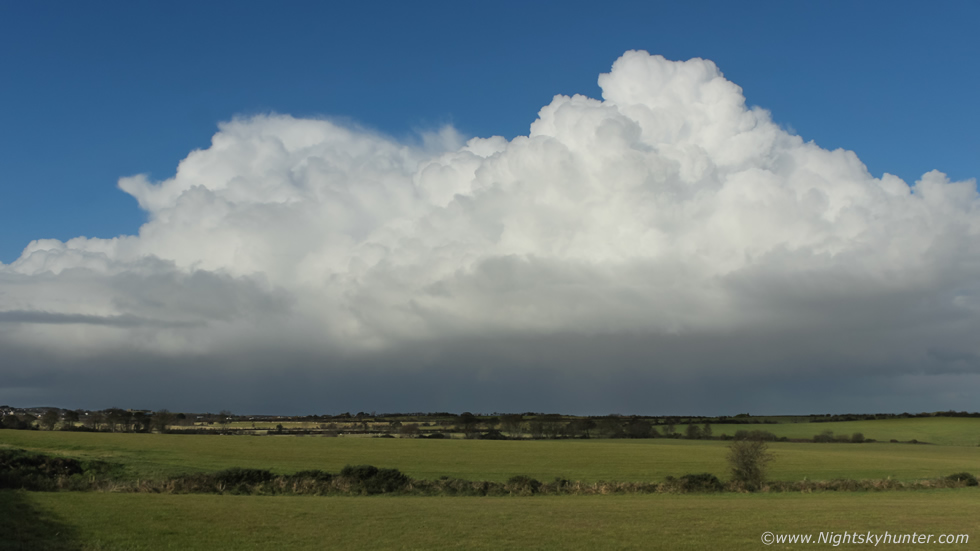 |
My expectations were low however as I continued N past Maghera and Swatragh I was delighted to see lines of wonderful cloudscapes. Towering Cumulus were visible all across the N and NE skyline with forming Cbs and to the NW was a stunning cell shinning brilliant white against the deep blue background sky. The sight of pristine cold Winter-like convection was a sight to behold, it felt like meeting an old friend once again. From my distant vantage point I correctly inferred the cell was over the ocean beyond Co. Donegal so for it to look so striking from this range was a very encouraging sign. As I drove I observed several tall updraught towers, both were very solid and even had knuckles on the back of their cauliflower heads, I felt the urge to get there as son as I could so I put my foot down but knew it would be some time before I got into the target area, I wondered would the scene hold together long enough for me to get there on time.
I arrived at the north coast and drove along the coastal route, I finally found a good open view and pulled into an entrance to a field outside Articlave for a look. The cell was moving from L to R and towards me at the same time on the NW flow, I got a quick shot with 18-55mm kit lens as it was passing over the land mass of Donegal, I could discern a long gust front feature running the entire length of the cell. I got back in the van and continued driving, I wanted to get to a beach to get a better view.
 |
The scene just kept getting better and better, I wanted another image so I pulled over between Articlave and Downhill for more. The cell was moving in fast and I now had a terrific view, I left the van idling and ran across to the other side of the road to get away from low hanging phone lines. This time I was using the 15mm ultra wide angle on full frame to take in the view. First decent convective sight I've seen in a long time, low topped cell in full sunshine, blue sky all around, sunlit ploughed field for foreground and falling from the towers were curtains of hail which looked like a murky veil draping over a developing gust front.
 |
I got back in the van and drove onto Downhill Beach and I was immediately out shooting with the same camera and lens. If I have a storm scene dominating the wide angle lens then I know I'm witnessing something decent. Large cell rite over the sea now close to the beach with rainbow and west side of the gust front making for a dramatic scene.
 |
Panning 90 degrees to my right looking due N showing a nice rainbow against battleship grey storm clouds which were getting darker by the minute. Amazingly the precip core stayed out to sea and I remained dry and comfortable the entire time except for the cold outflow wind blowing across the sand.
 |
Another 90 degrees to my right, I liked this moody scene with eastern side of gust front about to swallow up Mussenden Temple complimented by primary and secondary bows against a dense core. I watched for a while, especially the west side of the guster which looked dry and bulky with interesting scud under the main structure, for a short time this region was well separated from the core and almost had the look of an updraught base so I kept a visual on it in case of a funnel cloud or my dream waterspout then once it took on a more undercut outflow appearance I got back in the van and drove on.
 |
I drove onto Benone beach where Nigel was already parked and shooting the scene, he had been in a great position to watch the entire cell approach from the distance and even got a lovely panorama. The show was far from over yet, this cell had slowed down its forward speed and just seemed to be creeping along. As that interesting gust front neared it looked very dramatic crossing the beach heading rite for our position, this was turning out to be a rather photogenic day, I was actually surprised by the caliber of clouds we were seeing, we were enjoying every minute of it.
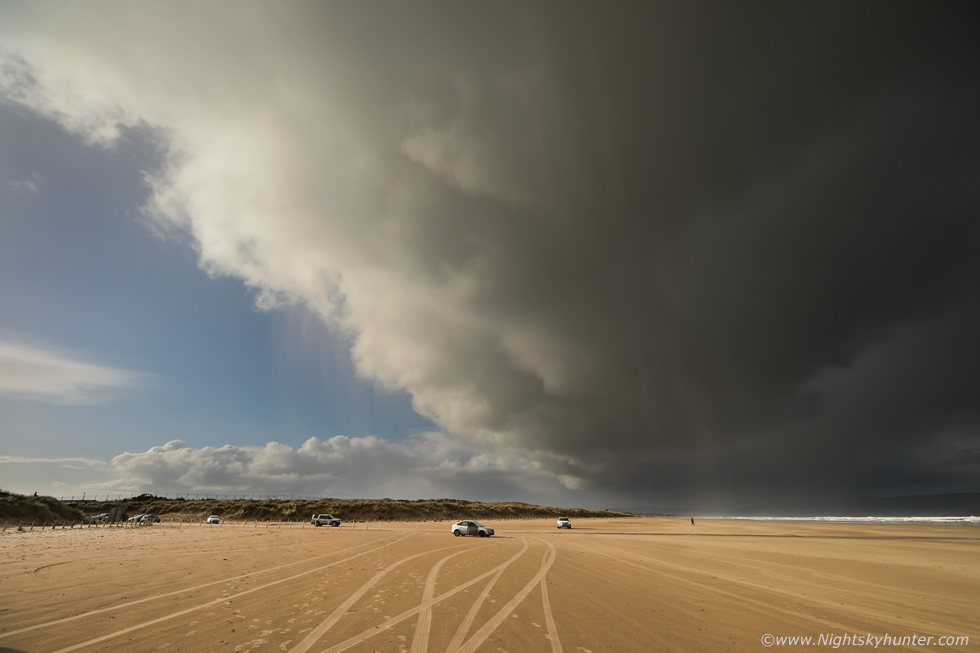 |
We were captivated by the sight of huge streaks of hail falling from the gust front, I was still using my 15mm Irix on the 5D full frame so this is showing a massive area of sky, it seemed the hail on this side was only just developing.
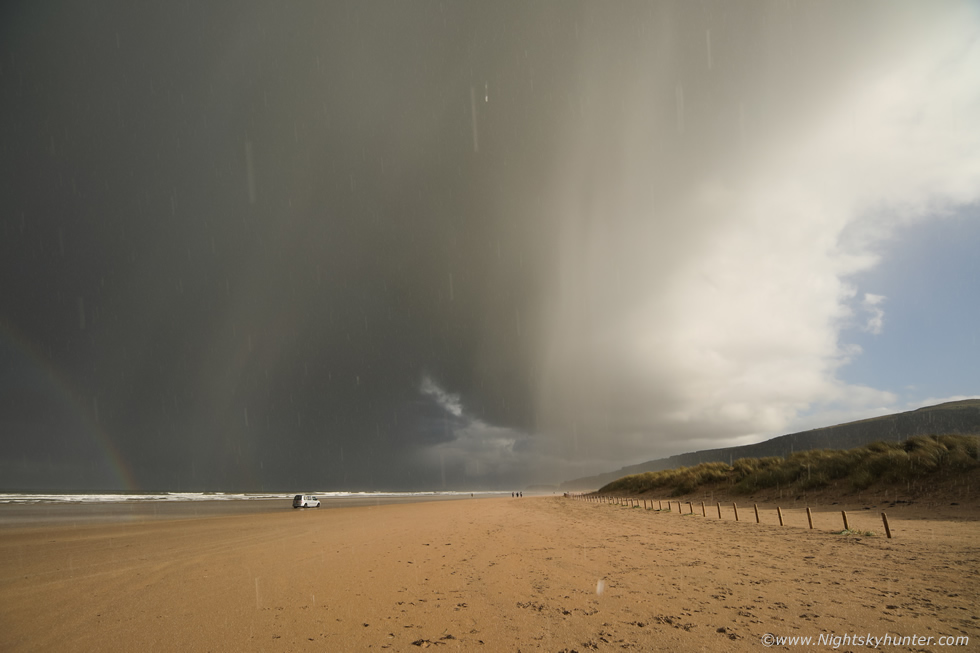 |
Then suddenly it went crazy with a proper deluge of hail stones falling from the sky. They made a brilliant sound as they clanked against the metal bodywork of both our vans, the scene was so cool looking I wanted to get an image so I ran outside to the back of the van, swung open both doors to grab my camera, then got smacked in the face by hail. I was shocked how big and solid and clear the hail stones were, they actually hurt on impact. I turned my back to the van for shelter and began shooting down the beach while the hail was at its most intense. I love this scene with the sky full of falling hailstones, some so large and close to the camera that you can see large streaks on the image, also the height they fell from was quite notable, the numerous shafts of hail were spectacular to watch, especially against the back drop of the main core and dark clouds with the beach for foreground. The best hail I've experienced in a very long time and my first taste of Winter of the season.
 |
Crop from another capture showing the main hail core with walkers on the beach getting hammered. That long vertical feature between the van and bow and on the right side against the clear air isn't sunbeams, that's the hail curtains. When the cell passed our cameras and ourselves were absolutely drenched, we were buzzing from the encounter. After being rewarded with such photogenic skies so early we were excited about what else was to come this day, it was now only midday and maximum CAPE wasn't until 15.00 before vanishing at sunset.
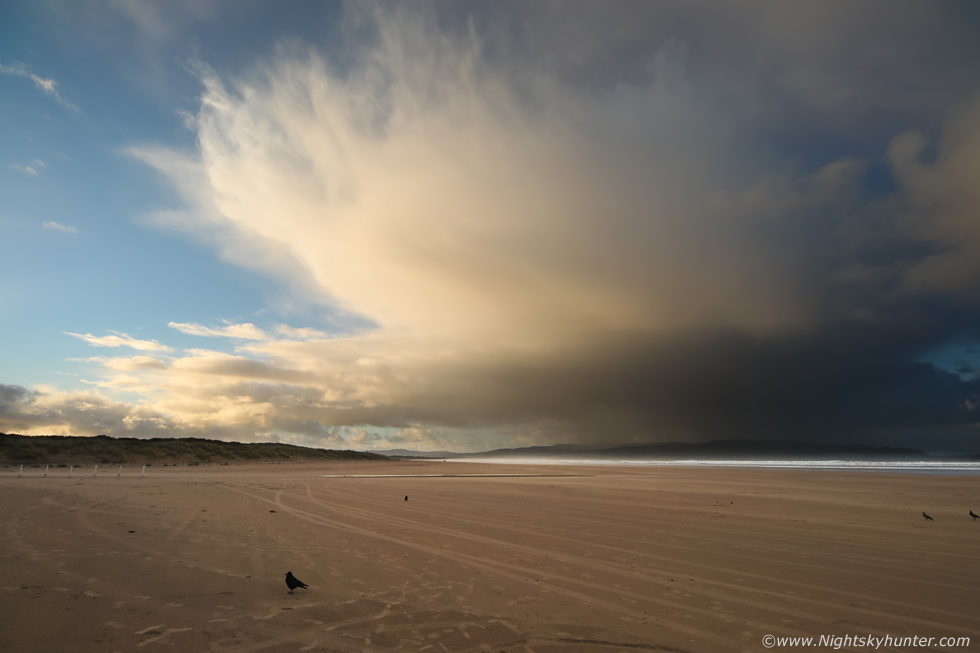 |
Colleen Webb arrived then the three of us spent the rest of the day on the beach watching the skies with high expectations. Astonishingly the cloudscapes went down hill rather fast. Shower frequency became sparse and any convection we did see was small and soft was fluffy tops, nothing looked solid or as dramatic as anything we had seen earlier, the entire caliber of skyscapes had changed. We stood around on the cold sand loosing body heat waiting for something, anything we could shoot, but it was becoming a desperate situation. After a few hours we were getting chilled and loosing motivation from the lack of action and we suspected something was wrong with the forecast, it was my belief that the CAPE had passed through much earlier than expected so we had already seen the best of what this day had to offer.
However we don't give up easily, we spotted a distant shower on the other side of Donegal and based on its position and track we knew it was going to hit us later, also the sun was getting very low and by the time the shower arrived it would be close to sunset. We wondered, could we get a nice sunset cloudscape or perhaps a good sunset rainbow? (that's the official terminology). We were all tempted to call it a day and head home but remained positive that a photo opportunity was brewing so remained tenacious and waited. That shower looked a little pathetic from a distance with fuzzy decaying tops and it was taking forever to get here on the now slack breeze, would all the ingredients comet together at the rite time for a sunset sky show? This was the shower at 15mm as it approached, it didn't look like much and was barely holding together but in the last minute the core seemed to become more dense and intensified then it hit us.
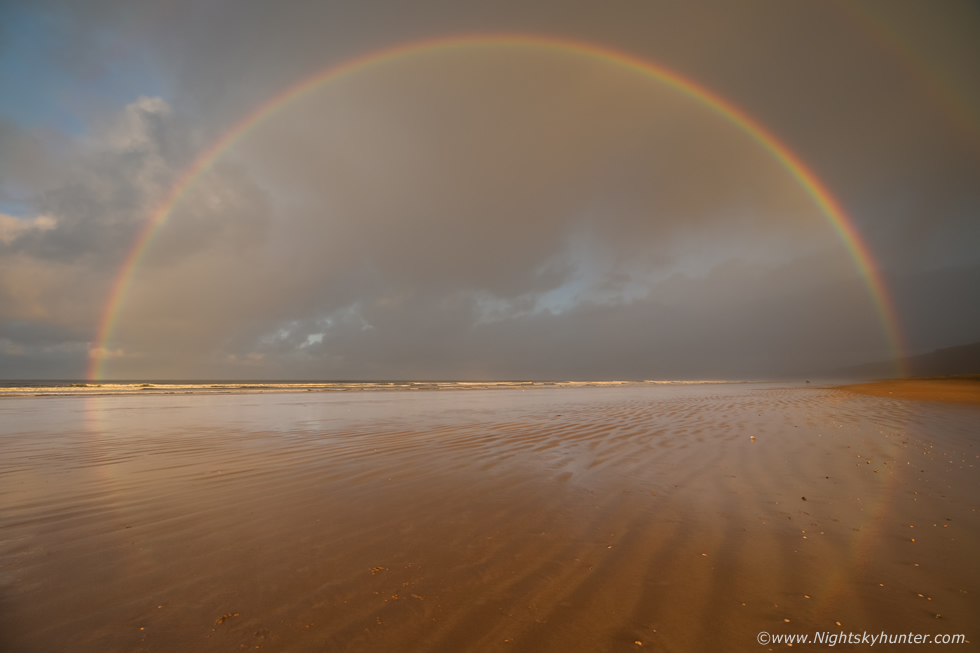 |
Rain hammered us as we took shelter inside the vehicles then after a few minutes the sun came out and lit up the back end of the precip core and formed a stunning sight. A beautiful complete sunset rainbow formed over the beach, we were all outside running across the sand getting images, this was all happening as heavy rain still fell so we were all getting soaked to the skin and our cameras got a good drenching, but it was worth it.
 |
I didn't notice it at the time but when I examined the twenty or so images I took of this rainbow I noticed a peculiar form visible to the upper right between the primary and secondary bows. It looked like a fainter third rainbow, three rainbows?, I contacted Nigel and Colleen who examined their own images and they both confirmed the phenomena was visible too. So this feature was present on three different camera-lens combinations at the same time so it must have been a real arc and not a lens artifact. After a little research I was fairly certain this is what's known as a 'reflection bow'. I contacted atmospherics optics expert Les Cowley and sent him the images and he confirmed that this was indeed a rare reflection rainbow. We were all delighted catching this elusive optical phenomena, out of all the years I have photographing weather and storms I've never seen or captured anything like this before, I was aware that such phenomena existed but I never believed I would get it on camera as the odds seemed so low. This was our reward for waiting for hours on that cold beach going on nothing more than our instincts. According to Mr Cowley...
''The centres of reflection bows are at the same altitude as the sun - the anthelic point. This is the same distance above the horizon as the centres of normal bows are below it at the antisolar point. The normal bow and its corresponding reflection bow intersect at the horizon''.
''Reflection bows are usually brightest when the sun is low because then its light is reflected most strongly from water surfaces. The normal and reflection bows draw closer together as the sun gets lower. The source of the reflected light is usually water behind you, i.e. sunwards. It can be in front of you but then only the base of the reflected bow will be seen''.
 |
The reflection bow is quite prominent in this image now that you know what to look for, I wont annotate the image this time, can you find it yourself?
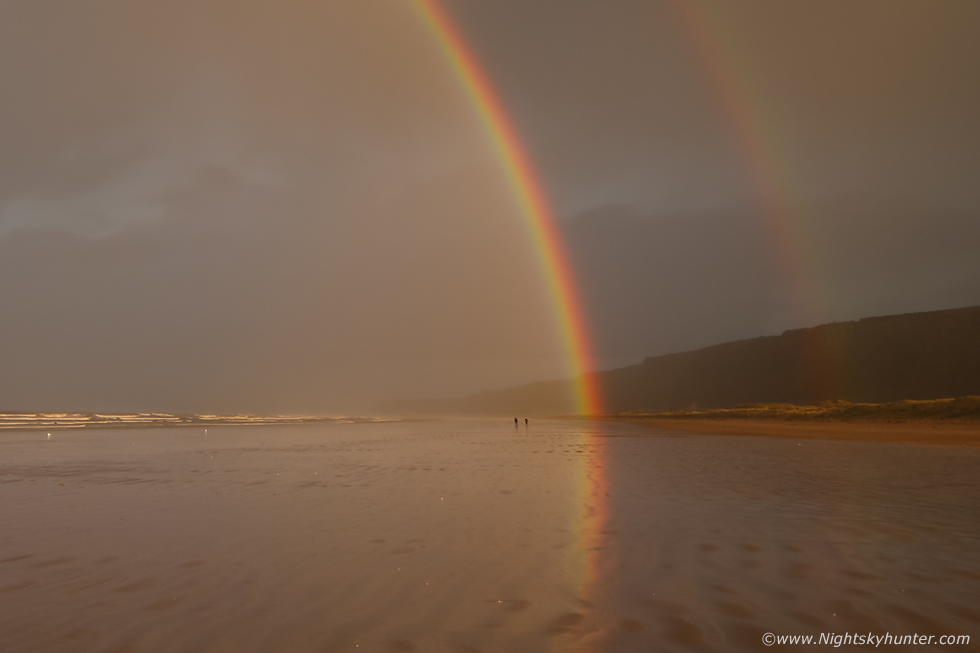 |
The vivid base of the primary and secondary bows looked fantastic reflecting upon the water with this couple walking along the beach. I should have used a telephoto lens and captured them filling the frame with the bow behind but instead I cropped in this image somewhat.
 |
I liked the linear pattern on the sand leading the eye onto the base of the bows, the reflection bow is still faintly visible to the mid upper area within Alexander's dark band between the primary and secondary. All three of us stood their all within our element drenched in rain but not caring, when nature shows off we enjoy every second of that magic.
 |
The bows were beginning to fade however the sunset light on the sand dunes and mountain was just gorgeous. This was one of those times when I bet 100% that I would have captured a 360 degree sunset rainbow extending from the sky all across the beach and merging back into the sky again, this would have been an epic capture with the Mavic however due to constant rain falling a flight was just not possible, but I'm not complaining, I'm happy to get any record of it at all.
 |
Turning around to the W moments before sunset. What a great scene, this was the cloud associated with the flank of the shower lit by golden hour light. Then the sun set and the bows and light were gone, what a fantastic way to end our first chase of the season. Our hands were red with cold but we happily said our farewells and warmed up inside before heading for home.
Video clip of the morning hail shower core as hail fell in dramatic streaks from the sky while clanging off the van, I really should have shot more video this day including the sunset rainbow however I was admittedly too engrossed in taking still images. I hope you enjoyed this adventure, thanks very much for reading.
Martin McKenna